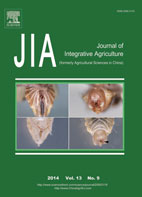|
|
Population Genetic Analysis of Blumeria graminis f. sp. tritici in Qinghai Province, China
XU Zhi, DUAN Xia-yu, ZHOU Yi-lin, GUO Qing-yun, YAO Qiang , CAO Shi-qin
2014, 13(9):
1952-1961.
DOI: 10.1016/S2095-3119(13)60591-2
To gain more precise information about molecular genetic variation for wild populations of Blumeria graminis f. sp. tritici from Qinghai Province, China, 38 single-colony isolates were purified from samples collected from Haidong District, Xining City and Hainan Tibetan Autonomous Prefecture in 2010. The virulence of 21 isolates among them was tested at seedling stage on 34 wheat cultivars (lines) carrying known powdery mildew (Pm) resistant genes. The results showed that V1a, V3a, V3c, V3e, V5a, V6, V7, V8 and V19 had high virulence frequencies (>75%), indicating a wide distribution; and V1c, V5b, V12, V13, V16, V21, VXBD, V2+6, V2+Mld and V4+8, with less distribution, appeared to be lower in frequencies (0-20%). The Nei’s gene diversity (H), Shannon’s information index (I) and the percentage of polymorphic loci (P) were 0.23, 0.35 and 67.65%, respectively, which revealed a virulent diversity. The results from single nucleotide polymorphisms (SNPs) of 38 isolates showed that three housekeeping genes were found to contain a total of 9 SNP sites. 10 haplotypes (H1-H10) were inferred from the concatenated sequences, with 1 haplotype (H1) comprising of over 55% of Qinghai population. Phylogenic analysis did not show obvious geographical subdivision between the isolates. A multilocus haplotype network presented a radial structure, with H1 in the central as an inferred ancestor. Using analysis of molecular variance (AMOVA), we found 1.63% of the total variation was among populations and 98.37% within populations, with a low fixations index (FST=0.01634, P<0.05). This revealed a relatively high genetic diversity but a low genetic divergence in Qinghai population. Moreover, the molecular data on gene flow (Nm=6.32) confirmed the migration of pathogen populations among areas in Qinghai Province.
|
